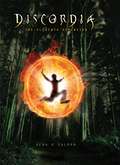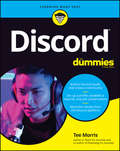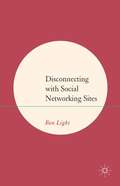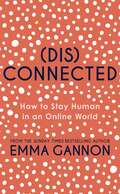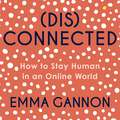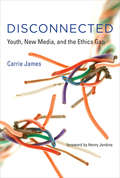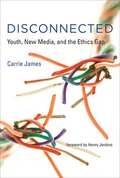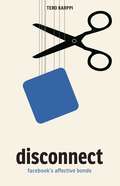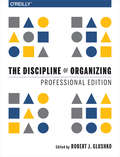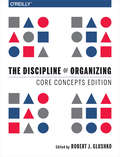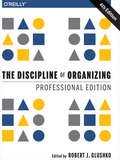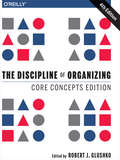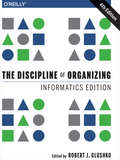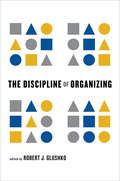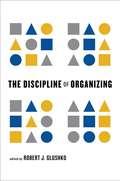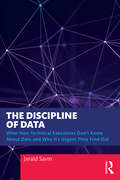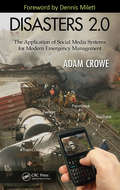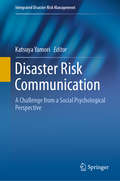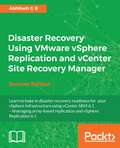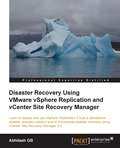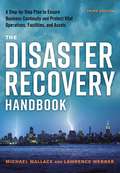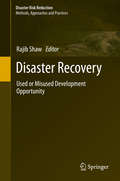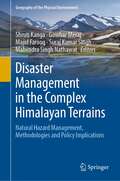- Table View
- List View
Discover SAP CRM (2nd Edition)
by Srini KattaDiscover what SAP CRM is and whether it's right for your business Learn from practical customer examples and real world insight New coverage of mobility, incident management, partner channel management, and more 2nd edition: Fully updated and expanded. It's a fact: companies that lose their customer undivided attention and sight of their customers' needs will lose those customers. SAP CRM provides you with the tools you need to attract and retain quality customers. Whether you're new to SAP or need to brush up on SAP CRM, this book will explain the core areas of CRM in an easy-to-understand manner. Perfect for managers and consultants, this book comprehensively explains what SAP CRM is, how it can improve your relationship with your customers, and how it can enhance cost effectiveness while improving profitability. Achieve customer-driven growth and explore the different ways SAP CRM can be integrated into your business. Supported by customer examples and practical insight, learn how SAP CRM works in the real world. Highlights- Marketing, sales, and service- Interaction centers- Web channels- Mobile applications- Partner channel management- Master data- Industry verticals.
Discordia: The Eleventh Dimension
by Dena K. SalmonAn avid player of the online fantasy game "Discordia", Lance wishes he could spend all of his time in the game -- and his wish is soon granted. Before he's allowed to leave this perilous Eleventh Dimension, he must complete a high-level quest that may determine Discordia's survival -- and Lance's, too.
Discord For Dummies
by Tee MorrisBuild a Discord studio and create a community Set up a profile, establish a channel, and join conversations Maximize results from the Discord platform Harmonize with your audience on Discord This evolving digital age offers numerous options for instant communications. Discord has emerged as a major player in connecting people from all parts of the world via text, audio, and video. Originally favored by the online gaming community, Discord now attracts content creators of all backgrounds eager to cultivate communities around all types of topics. Written by an expert in personal broadcasting for business or pleasure, the book is ideal for anyone looking to connect with a larger audience. Inside... Set up your profile Establish a server Join conversations Play by the rules Build a studio Create a community Apply Discord to your daily routine
Disconnecting with Social Networking Sites
by Ben LightBen Light puts forward an alternative way of thinking about how we engage with social networking sites, going beyond the emphasis upon connectivity that has been associated with research in the area to date. Analysing our engagements and disengagements with social networking sites in public (in cafes and at bus stops), at work (at desks, and photocopiers and whilst cleaning), in our personal lives (where we cull friends and gossip on backchannels) and as related to our health and wellbeing (where we restrict our updates), he emphasises the importance of disconnection instead of connection. The book, therefore, produces a theory of disconnective practice. This theory requires our attention to geographies of disconnection that include relations with a site, within a site, between sites and between sites and a physical world. Attention to disconnectors, as human and non-human is required, and the modes by which disconnection can occur can then be revealed. Light argues that diversity in the exercise of power is key to understanding disconnective practice where social networking sites are concerned, and he suggests that the ethics of disconnection may also require interrogation.
Disconnected: How to Stay Human in an Online World
by Emma GannonPRE-ORDER NOW: The new book by Sunday Times bestselling author, Emma Gannon I love Emma Gannon's wise and refreshing perspective on work, and more broadly on the challenges of building a meaningful life in an era of distraction, overwhelm and uncertainty. - Oliver Burkeman, New York Times Bestselling author of Four Thousand Weeks__________Millennials might have grown up online but now they want to log off. And it's not just millennials. A year of lockdowns, Zoom meetings and reduced physical contact has made us more dependent on the internet than ever before - but has it lost its humanity? Our focus on community and real connection has been sent off-course and we're becoming more aware of how the algorithm manipulates us and how our data has made us a product to be sold. So, where do we go from here and how can we get back on track? (Dis)connected examines these topics and offers tangible tips and advice for those of us who might feel a little lost right now and want to find themselves again.__________Emma Gannon is a cordial and provocative spirit. Read her, listen to her, explore her world and the world at large through her eyes. Hers is a journey well worth taking. - Julia Cameron, New York Times Bestselling author of The Artist's Way
Disconnected: How to Stay Human in an Online World
by Emma GannonMillennials might have grown up online but now they want to log off. And it's not just millennials. A year of lockdowns, Zoom meetings and reduced physical contact has made us more dependent on the internet than ever before - but has it lost its humanity? Our focus on community and real connection has been sent off-course and we're becoming more aware of how the algorithm manipulates us and how our data has made us a product to be sold. So, where do we go from here and how can we get back on track? (Dis)connected examines these topics and offers tangible tips and advice for those of us who might feel a little lost right now and want to find themselves again.(P) 2022 Hodder & Stoughton Limited
Disconnected: Youth, New Media, and the Ethics Gap (The John D. and Catherine T. MacArthur Foundation Series on Digital Media and Learning)
by Carrie JamesHow young people think about the moral and ethical dilemmas they encounter when they share and use online content and participate in online communities.Fresh from a party, a teen posts a photo on Facebook of a friend drinking a beer. A college student repurposes an article from Wikipedia for a paper. A group of players in a multiplayer online game routinely cheat new players by selling them worthless virtual accessories for high prices. In Disconnected, Carrie James examines how young people and the adults in their lives think about these sorts of online dilemmas, describing ethical blind spots and disconnects. Drawing on extensive interviews with young people between the ages of 10 and 25, James describes the nature of their thinking about privacy, property, and participation online. She identifies three ways that young people approach online activities. A teen might practice self-focused thinking, concerned mostly about consequences for herself; moral thinking, concerned about the consequences for people he knows; or ethical thinking, concerned about unknown individuals and larger communities. James finds, among other things, that youth are often blind to moral or ethical concerns about privacy; that attitudes toward property range from “what's theirs is theirs” to “free for all”; that hostile speech can be met with a belief that online content is “just a joke”; and that adults who are consulted about such dilemmas often emphasize personal safety issues over online ethics and citizenship. Considering ways to address the digital ethics gap, James offers a vision of conscientious connectivity, which involves ethical thinking skills but, perhaps more important, is marked by sensitivity to the dilemmas posed by online life, a motivation to wrestle with them, and a sense of moral agency that supports socially positive online actions.
Disconnected
by Carrie JamesFresh from a party, a teen posts a photo on Facebook of a friend drinking a beer. A college student repurposes an article from Wikipedia for a paper. A group of players in a multiplayer online game routinely cheat new players by selling them worthless virtual accessories for high prices. In Disconnected, Carrie James examines how young people and the adults in their lives think about these sorts of online dilemmas, describing ethical blind spots and disconnects. Drawing on extensive interviews with young people between the ages of 10 and 25, James describes the nature of their thinking about privacy, property, and participation online. She identifies three ways that young people approach online activities. A teen might practice self-focused thinking, concerned mostly about consequences for herself; moral thinking, concerned about the consequences for people he knows; or ethical thinking, concerned about unknown individuals and larger communities. James finds, among other things, that youth are often blind to moral or ethical concerns about privacy; that attitudes toward property range from "what's theirs is theirs" to "free for all"; that hostile speech can be met with a belief that online content is "just a joke"; and that adults who are consulted about such dilemmas often emphasize personal safety issues over online ethics and citizenship. Considering ways to address the digital ethics gap, James offers a vision of conscientious connectivity, which involves ethical thinking skills but, perhaps more important, is marked by sensitivity to the dilemmas posed by online life, a motivation to wrestle with them, and a sense of moral agency that supports socially positive online actions.
Disconnect: Facebook's Affective Bonds
by Tero KarppiAn urgent examination of the threat posed to social media by user disconnection, and the measures websites will take to prevent it No matter how pervasive and powerful social media websites become, users always have the option of disconnecting—right? Not exactly, as Tero Karppi reveals in this disquieting book. Pointing out that platforms like Facebook see disconnection as an existential threat—and have undertaken wide-ranging efforts to eliminate it—Karppi argues that users’ ability to control their digital lives is gradually dissipating. Taking a nonhumancentric approach, Karppi explores how modern social media platforms produce and position users within a system of coded relations and mechanisms of power. For Facebook, disconnection is an intense affective force. It is a problem of how to keep users engaged with the platform, but also one of keeping value, attention, and desires within the system. Karppi uses Facebook’s financial documents as a map to navigate how the platform sees its users. Facebook’s plans to connect the entire globe through satellites and drones illustrates the material webs woven to keep us connected. Karppi analyzes how Facebook’s interface limits the opportunity to opt-out—even continuing to engage users after their physical death. Showing how users have fought to take back their digital lives, Karppi chronicles responses like Web2.0 Suicide Machine, an art project dedicated to committing digital suicide. For Karppi, understanding social media connectivity comes from unbinding the bonds that stop people from leaving these platforms. Disconnection brings us to the limit of user policies, algorithmic control, and platform politics. Ultimately, Karppi’s focus on the difficulty of disconnection, rather than the ease of connection, reveals how social media has come to dominate human relations.
The Discipline of Organizing: Professional Edition
by Robert J. GlushkoNote about this ebook: This ebook exploits many advanced capabilities with images, hypertext, and interactivity and is optimized for EPUB3-compliant book readers, especially Apple's iBooks and browser plugins. These features may not work on all ebook readers.We organize things. We organize information, information about things, and information about information. Organizing is a fundamental issue in many professional fields, but these fields have only limited agreement in how they approach problems of organizing and in what they seek as their solutions.The Discipline of Organizing synthesizes insights from library science, information science, computer science, cognitive science, systems analysis, business, and other disciplines to create an Organizing System for understanding organizing. This framework is robust and forward-looking, enabling effective sharing of insights and design patterns between disciplines that weren't possible before.The Professional Edition includes new and revised content about the active resources of the "Internet of Things," and how the field of Information Architecture can be viewed as a subset of the discipline of organizing. You'll find:600 tagged endnotes that connect to one or more of the contributing disciplinesNearly 60 new pictures and illustrationsLinks to cross-references and external citationsInteractive study guides to test on key pointsThe Professional Edition is ideal for practitioners and as a primary or supplemental text for graduate courses on information organization, content and knowledge management, and digital collections.
The Discipline of Organizing: Core Concepts Edition
by Robert J. GlushkoNote about this ebook: This ebook exploits many advanced capabilities with images, hypertext, and interactivity and is optimized for EPUB3-compliant book readers, especially Apple's iBooks and browser plugins. These features may not work on all ebook readers.We organize things. We organize information, information about things, and information about information. Organizing is a fundamental issue in many professional fields, but these fields have only limited agreement in how they approach problems of organizing and in what they seek as their solutions.The Discipline of Organizing synthesizes insights from library science, information science, computer science, cognitive science, systems analysis, business, and other disciplines to create an Organizing System for understanding organizing. This framework is robust and forward-looking, enabling effective sharing of insights and design patterns between disciplines that weren't possible before.Ideal as a textbook for undergraduates, the Core Concepts Edition includes new and revised content about the active resources of the "Internet of Things," and how the field of Information Architecture can be viewed as a subset of the discipline of organizing. You'll find:Stop and Think exercises designed to increase engagement and comprehensionUser-contributed case studies to help you with your own organizing problemsNearly 60 new pictures and illustrationsLinks to cross-references and external citationsInteractive study guides to test on key points
The Discipline of Organizing: Professional Edition
by Robert J. GlushkoWe organize things. We organize information, information about things, and information about information. Organizing is a fundamental issue in many professional fields, but these fields have only limited agreement in how they approach problems of organizing and in what they seek as their solutions. The Discipline of Organizing synthesizes insights from library science, information science, computer science, cognitive science, systems analysis, business, and other disciplines to create an Organizing System for understanding organizing. This framework is robust and forward-looking, enabling effective sharing of insights and design patterns between disciplines that weren't possible before. The 4th edition of this award-winning and widely adopted text adds content to bridge between the foundations of organizing systems and the new statistical and computational techniques of data science because at its core, data science is about how resources are described and organized. The 4th edition reframes descriptive statistics as organizing techniques, expands the treatment of classification to include computational methods, and incorporates many new examples of data-driven resource selection, organization, maintenance, and personalization. The Professional edition remains the definitive source for advanced students and practitioners who require comprehensive and pinpoint connections to the classic and contemporary literature about organizing. Dozens of new citations and endnotes for the new data science material bring to 12 the number of distinct disciplinary perspectives identified in the book.
The Discipline of Organizing: Core Concepts Edition
by Robert J. GlushkoWe organize things. We organize information, information about things, and information about information. Organizing is a fundamental issue in many professional fields, but these fields have only limited agreement in how they approach problems of organizing and in what they seek as their solutions. The Discipline of Organizing synthesizes insights from library science, information science, computer science, cognitive science, systems analysis, business, and other disciplines to create an Organizing System for understanding organizing. This framework is robust and forward-looking, enabling effective sharing of insights and design patterns between disciplines that weren't possible before. The 4th edition of this award-winning and widely adopted text adds content to bridge between the foundations of organizing systems and the new statistical and computational techniques of data science because at its core, data science is about how resources are described and organized. The 4th edition reframes descriptive statistics as organizing techniques, expands the treatment of classification to include computational methods, and incorporates many new examples of data-driven resource selection, organization, maintenance, and personalization. The Core Concepts edition is an abridged version that is simpler to read because it does not tempt the reader with the deep scholarly web of endnotes contained in the Professional edition. Instead, it seeks to reinforce the concepts and design patterns with numerous "Stop and Think" exercises, and omits some of the theoretical nuance of the Professional edition to put more emphasis on concrete examples.
The Discipline of Organizing: Informatics Edition
by Robert J. GlushkoWe organize things. We organize information, information about things, and information about information. Organizing is a fundamental issue in many professional fields, but these fields have only limited agreement in how they approach problems of organizing and in what they seek as their solutions. The Discipline of Organizing synthesizes insights from library science, information science, computer science, cognitive science, systems analysis, business, and other disciplines to create an Organizing System for understanding organizing. This framework is robust and forward-looking, enabling effective sharing of insights and design patterns between disciplines that weren't possible before. The 4th edition of this award-winning and widely adopted text adds content to bridge between the foundations of organizing systems and the new statistical and computational techniques of data science because at its core, data science is about how resources are described and organized. The 4th edition reframes descriptive statistics as organizing techniques, expands the treatment of classification to include computational methods, and incorporates many new examples of data-driven resource selection, organization, maintenance, and personalization. The Informatics edition contains all the new content related to data science, but omits the discipline-specific content about library science, museums, and document archives.
The Discipline of Organizing (The\mit Press Ser.)
by Robert J. Glushko et alA framework for the theory and practice of organizing that integrates the concepts and methods of information organization and information retrieval.Organizing is such a common activity that we often do it without thinking much about it. In our daily lives we organize physical things—books on shelves, cutlery in kitchen drawers—and digital things—Web pages, MP3 files, scientific datasets. Millions of people create and browse Web sites, blog, tag, tweet, and upload and download content of all media types without thinking “I'm organizing now” or “I'm retrieving now.”This book offers a framework for the theory and practice of organizing that integrates information organization (IO) and information retrieval (IR), bridging the disciplinary chasms between Library and Information Science and Computer Science, each of which views and teaches IO and IR as separate topics and in substantially different ways. It introduces the unifying concept of an Organizing System—an intentionally arranged collection of resources and the interactions they support—and then explains the key concepts and challenges in the design and deployment of Organizing Systems in many domains, including libraries, museums, business information systems, personal information management, and social computing.Intended for classroom use or as a professional reference, the book covers the activities common to all organizing systems: identifying resources to be organized; organizing resources by describing and classifying them; designing resource-based interactions; and maintaining resources and organization over time. The book is extensively annotated with disciplinary-specific notes to ground it with relevant concepts and references of library science, computing, cognitive science, law, and business.
The Discipline of Organizing
by Robert J. Glushko et alAbstract: We organize things, we organize information, we organize information about things, and we organize information about information. But even though "organizing" is a fundamental and ubiquitous challenge, when we compare these activities their contrasts are more apparent than their commonalities. We propose to unify many perspectives about organizing with the concept of an Organizing System, defined as an intentionally arranged collection of resources and the interactions they support. Every Organizing System involves a collection of resources, a choice of properties or principles used to describe and arrange resources, and ways of supporting interactions with resources. By comparing and contrasting how these activities take place in different contexts and domains, we can identify patterns of organizing. We can create a discipline of organizing in a disciplined way.
The Discipline of Data: What Non-Technical Executives Don't Know About Data and Why It's Urgent They Find Out
by Jerald SavinPulling aside the curtain of ‘Big Data’ buzz, this book introduces C-suite and other non-technical senior leaders to the essentials of obtaining and maintaining accurate, reliable data, especially for decision-making purposes. Bad data begets bad decisions, and an understanding of data fundamentals — how data is generated, organized, stored, evaluated, and maintained — has never been more important when solving problems such as the pandemic-related supply chain crisis. This book addresses the data-related challenges that businesses face, answering questions such as: What are the characteristics of high-quality data? How do you get from bad data to good data? What procedures and practices ensure high-quality data? How do you know whether your data supports the decisions you need to make? This clear and valuable resource will appeal to C-suite executives and top-line managers across industries, as well as business analysts at all career stages and data analytics students.
The Discipline of Data: What Non-Technical Executives Don't Know About Data and Why It's Urgent They Find Out
by Jerald SavinPulling aside the curtain of ‘Big Data’ buzz, this book introduces C-suite and other non-technical senior leaders to the essentials of obtaining and maintaining accurate, reliable data, especially for decision-making purposes. Bad data begets bad decisions, and an understanding of data fundamentals — how data is generated, organized, stored, evaluated, and maintained — has never been more important when solving problems such as the pandemic-related supply chain crisis. This book addresses the data-related challenges that businesses face, answering questions such as: What are the characteristics of high-quality data? How do you get from bad data to good data? What procedures and practices ensure high-quality data? How do you know whether your data supports the decisions you need to make? This clear and valuable resource will appeal to C-suite executives and top-line managers across industries, as well as business analysts at all career stages and data analytics students.
Disasters 2.0: The Application of Social Media Systems for Modern Emergency Management
by Adam CroweEmerging social media and so-called Web 2.0 technologies will continue to have a great impact on the practice and application of the emergency management function in every public safety sector. Disasters 2.0: The Application of Social Media Systems for Modern Emergency Management prepares emergency managers and first responders to successfully appl
Disaster Risk Communication: A Challenge from a Social Psychological Perspective (Integrated Disaster Risk Management)
by Katsuya YamoriThis book provides a unique blend of integrated disaster risk communication research conducted by authors with diverse backgrounds, including social psychology, sociology, civil engineering, informatics, and meteorology. It reports on the latest advances in collaborative and participatory action research on community-based disaster management from the frontline in Japan, Nepal, China and the USA. In addition, it employs and integrate a broad range of methodologies, including mathematical analyses, computer simulations, questionnaire surveys, gaming approaches, and participatory observation. Each chapter deals with disaster risk communication initiatives to address various hazards, such as earthquakes, tsunamis, floods and landslides, which are uniquely integrated from a social psychological perspective.
Disaster Recovery Using VMware vSphere Replication and vCenter Site Recovery Manager - Second Edition
by Abhilash G BLearn to bake in disaster recovery readiness for your vSphere Infrastructure using vCenter SRM 6.1, leveraging array-based replication and vSphere Replication 6.1 About This Book * This is the first book on the market that provides an extensive disaster recovery solution using the latest vSphere Replication and vCenter Site Recovery Manager * Master the skills of protecting your virtual machines by replicating and recovering them in seconds * This practical, step-by-step guide will help you protect all your applications with Site Recovery Manager and Replication Who This Book Is For If you are a system administrator who is looking for a disaster recovery solution using the latest VMware vSphere Replication and vCenter Site Recovery Manager, this book is perfect for you. You should have a basic knowledge of virtual machines and data center operations. What You Will Learn * Familiarize yourself with disaster recovery concepts and the architecture of vCenter Site Recovery Manager and vSphere Replication. * Deploy and Configure vCenter Site Recovery Manager to leverage array-based replication and vSphere Replication. * Use vSphere Replication as a standalone disaster recovery solution. * Enabling protection of Virtual Machines by creating Protection Groups. * Enable orchestration of the recovery of protected virtual machines by creating Recovery Plans. * Migrate virtual machine workload from one site to another using Recovery Plans * Testing and Performing a failover or failback of Virtual Machines using Recovery Plans * Enable vRealize Orchestrator Plugins for SRM and vSphere Replication. In Detail VMware vCenter Site Recovery manage is an orchestration tool used to automate disaster recovery in a manner that no other solution does. It is programmed to leverage array-based replication and VMware's proprietary vSphere Replication engine. The book begins by talking about the architecture of SRM and guides you through the procedures involved in installing and configuring SRM to leverage array-based replication. You will then learn how to protect your virtual machines by creating Protection Groups and validate their recoverability by testing recovery plans and even performing failover and failback. Moving on, you will learn how to install and configure vSphere Replication as a standalone disaster recovery solution. It also guides you through the procedures involved in configuring SRM to leverage vSphere replication. Finally, you will learn how to deploy and configure vRealize Orchestrator and its plugin for SRM and vSphere Replication. Style and approach This is a practical, step-by-step guide on implementing a disaster recovery solution for your organization using VMware vSphere Replication and vCenter Site Recovery Manager.
Disaster Recovery Using VMware vSphere Replication and vCenter Site Recovery Manager
by Abhilash GbIn Detail VMware vCenter Site Recovery Manager automates disaster recovery in a manner that no other solution does. It is programmed to leverage array-based replication and VMware's proprietary vSphere Replication engine. This book will familiarize you with the concepts of disaster recovery using vCenter Site Recovery Manager and vSphere Replication. You will learn how to deploy and confi gure vSphere Replication in the standalone mode to replicate virtual machines. You will also learn how to use vCenter Site Recovery Manager to leverage array-based replication or vSphere Replication, form Recovery Plans and orchestrate them to perform a test, Planned Migration, Failover, or Failback. Approach This is a step-by-step guide that will help you understand disaster recovery using VMware vSphere Replication 5.5 and VMware vCenter Site Recovery Manager (SRM) 5.5. The topics and configuration procedures are accompanied with relevant screenshots, flow-charts, and logical diagrams that makes grasping the concepts easier. Who this book is for This book is a guide for anyone who is keen on using vSphere Replication or vCenter Site Recovery Manager as a disaster recovery solution. This is an excellent handbook for solution architects, administrators, on-field engineers, and support professionals. Although the book assumes that the reader has some basic knowledge of data center virtualization using VMware vSphere, it can still be a very good reference for anyone who is new to virtualization.
The Disaster Recovery Handbook: A Step-by-Step Plan to Ensure Business Continuity and Protect Vital Operations, Facilities, and Assets
by Michael Wallace Lawrence WebberExpect the best. Plan for the worst.Survey the headlines: superstorms, data breaches, pandemics, system failures, and strikes occur regularly...somewhere. If a disaster hits your organization — will you be prepared? With the detailed guidance found in The Disaster Recovery Handbook, your company’s survival and the speedy resumption of business is assured.This thoroughly updated third edition provides readers with clear and comprehensive instructions for assessing risk; documenting recovery procedures; assembling a disaster team; testing and debugging every step; protecting material resources; and safeguarding vital records.Featuring an examination of emerging risks, developments in IT networking, and an all-new chapter on information security, this all-in-one tool kit helps you both avoid potential trouble and recover swiftly when the worst occurs.Anything can happen, but The Disaster Recovery Handbook helps you plan for every contingency, ensuring your company is responsible, ready, and resilient.
Disaster Recovery
by Rajib ShawThis book explains key lessons learned from diverse disaster situations and analyzes them within the framework of governance, education, and technology, providing a framework for disaster recovery as a development opportunity. In post-disaster situations, different types of resources are put into the affected region, varying according to technical, financial, intellectual, and community resources. If properly implemented, disaster recovery can change the context of risk-reduction approaches; if not, it can create additional hazards. In some countries, the post-disaster recovery process has even changed the socio-economic and political context of the affected region and country. The book has 21 chapters and is divided into four parts: governance and institutional issues (five chapters), education and learning issues (four chapters), technology and innovation issues (five chapters), and cross-cutting issues (five chapters). The final chapter provides an analysis of the key topics. The primary target groups for this book are students and researchers in the fields of environment, disaster risk reduction, and climate change studies. The book provides them with a good idea of the current research trends in the field and furnishes basic knowledge about these vital topics. Another target group comprises practitioners and policy makers, who will be able to apply the knowledge collected here to policy and decision making.
Disaster Management in the Complex Himalayan Terrains: Natural Hazard Management, Methodologies and Policy Implications (Geography of the Physical Environment)
by Mahendra Singh Nathawat Shruti Kanga Suraj Kumar Singh Gowhar Meraj Majid FarooqSouth Asia, harboring the complex Himalayan terrains, has over one-fifth of the world’s population and is recognized as the most hazard-prone region of the world. The exponential increase in population with the consequent pressure on natural resources and continued high rates of poverty and food insecurity also makes this region the most vulnerable region to hazards in the world as far as the impacts of climate change are concerned. Over the last century, the climatic trends in South-Asia have been observed to be characterized by increasing air temperatures and an increasing trend in the intensity and frequency of extreme events. IPCC (2014) has reported that the Himalayan highlands shall face significant warming over the next century. The increasing frequency of natural hazards due to the impacts of climate change in the Himalayas calls for efficient management and policymaking in these regions, which can only be implemented by the local governments through an established science-based robust action plan. This edited volume focuses on the management of natural hazards using innovative techniques of spatial information sciences and satellite remote sensing. It contains chapters from eminent researchers and experts in the field of hazard management, remote sensing, and GIS. The primary focus of this book is to replenish the gap in the available literature on the subject by bringing the concepts, theories, and practical experiences of the specialists and professionals in this field together in one volume to help students, researchers, and policymakers to address issues concerning management and policy implications of natural hazards in the complex Himalayan region.

